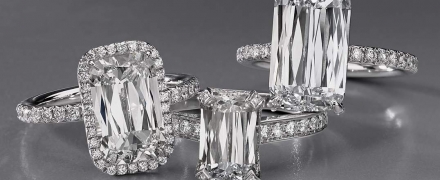open 10 am - 7 pm
laboratory is closed
Ashoka cut

An interesting fact is the name of the modern cut "Ashoka", created based on the old cut of a historic stone. When and by whom the diamond was found and whether it belonged to the legendary ruler of one of the most powerful states of India is unknown, but the legend connected this particular stone with the name of the ruler Ashoka. In 1947, this historic stone was first bought by Harry Winston's jewelry firm. Later, in 1977, an internationally renowned jeweler decided to re-cut the diamond in order to improve the symmetry of the stone. The legend, the name of the stone and the story of the successful re-cutting of the diamond prompted the designers of the William Goldberg Diamond Corporation to develop the cut applied to the mass production of stones that outwardly resemble the cut of the diamond bearing the name of Ashoka, the unifier of India. The industrial production method and the final cut design were developed in 1999, and in 2002 the cut was patented in the USA.
В геммологической практике бывают весьма увлекательные случаи с диагностикой ювелирных вставок
Но помимо редкости цвета и высокой стоимости таких камней, многие розовые камни выделяются одной замечательной особенностью – они проявляют плеохроизм, то есть в зависимости от положения осмотра камня он может иметь дополнительные оттенки – оранжевый или пурпурный.
Currently, gemstones are produced by two fundamentally different technological methods - the High Pressure - High Temperature method (“HPHT”, High-pressure & High-temperature) and the Chemical Vapor Deposition (“CVD”, Chemical vapor deposition) method. The "HPHT" method is the most tested classical synthesis method, which can be used both carbon deposition on diamond from flux melts and catalytic reactions. In "CVD" synthesis, diamond growth occurs on a seed during carbon deposition mainly from a gaseous medium at relatively low temperatures and pressures.
Jewelry and precious stones are just such a category of goods, when buying which you need to pay attention to many criteria.
Sogdianite is a rather rare mineral and more often it can be found as a collection material (moreover, in systematic collections), and it is extremely rare in jewelry.






